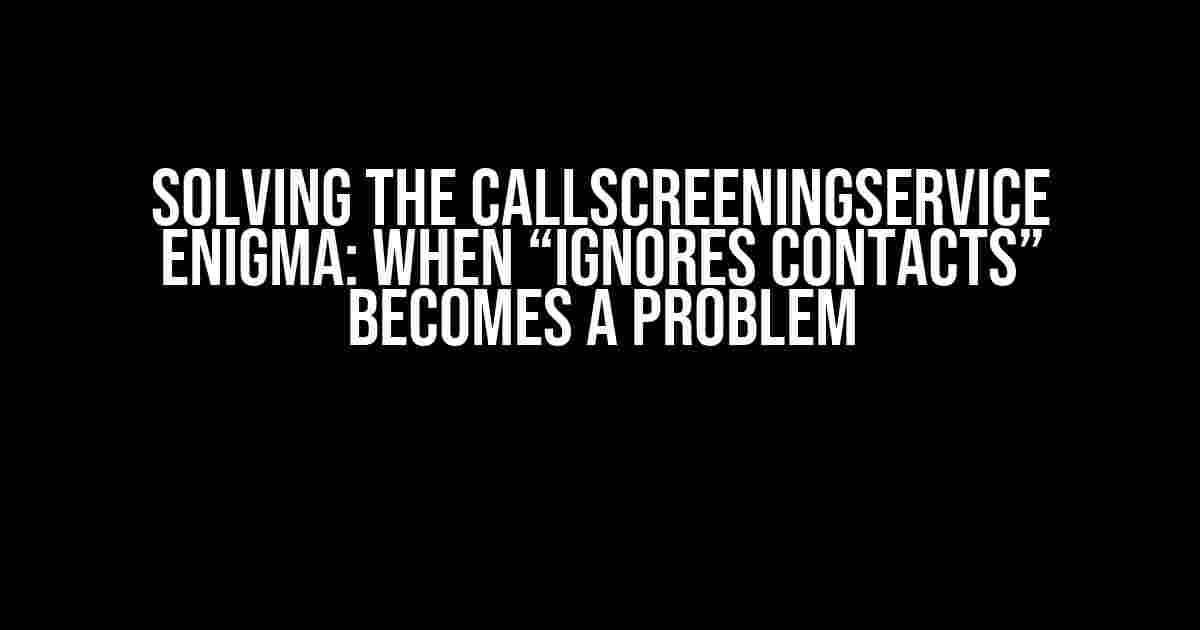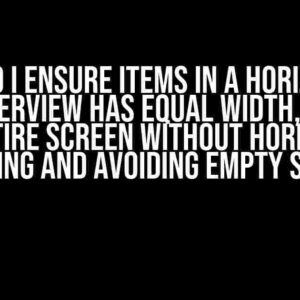Are you tired of dealing with the frustration of CallScreeningService ignoring your contacts, despite having granted the READ_CONTACTS permission? You’re not alone! In this in-depth guide, we’ll delve into the world of Android’s CallScreeningService, explore the reasons behind this annoying issue, and provide you with step-by-step solutions to overcome it.
What is CallScreeningService?
CallScreeningService is an Android service responsible for screening incoming calls, allowing your device to identify spam calls and take action accordingly. It relies on various factors, including your contact list, to make informed decisions about which calls to block or allow. Sounds great, right? Well, not when it starts ignoring your contacts…
The Problem: CallScreeningService Ignores Contacts
Imagine receiving a call from a familiar number, only to have CallScreeningService misbehave and block the call or fail to recognize it as a legitimate call from a contact. Frustrating, to say the least! This issue commonly arises when the service is unable to access your contact list, despite having granted the necessary permissions.
Why Does CallScreeningService Ignore Contacts?
Before we dive into the solutions, let’s explore the possible reasons behind this problem:
- Permission Issues: While you may have granted the READ_CONTACTS permission, other applications or system processes might be interfering with CallScreeningService’s ability to access your contact list.
- Contact List Corruption: A corrupted contact list or incorrect contact data can confuse CallScreeningService, leading it to ignore your contacts.
- App Conflicts: Other apps might be competing for access to your contact list, causing CallScreeningService to malfunction.
- System Bugs: Rarely, system bugs or Android updates can introduce issues with CallScreeningService, leading to contact list neglect.
Solving the Problem: Step-by-Step Instructions
Now that we’ve identified the possible culprits, let’s tackle the solutions:
Solution 1: Revoke and Re-Grant Permissions
Sometimes, simply revoking and re-granting the READ_CONTACTS permission can resolve the issue:
// Revoke permission
adb shell pm revoke com.android.providers.contacts android.permission.READ_CONTACTS
// Re-grant permission
adb shell pm grant com.android.providers.contacts android.permission.READ_CONTACTS
Run these commands in the Android Debug Bridge (ADB) shell to revoke and re-grant the permission.
Solution 2: Clear Contact List Cache
Clearing the contact list cache can help resolve corruption issues:
adb shell pm clear com.android.providers.contacts
Run this command to clear the contact list cache.
Solution 3: Disable and Re-enable Contact Sync
Disabling and re-enabling contact sync can sometimes resolve conflicts:
- Go to Settings > Accounts > [Your Account].
- Toggle off Contact Sync and wait for 10 seconds.
- Toggle Contact Sync back on.
Solution 4: Uninstall Conflicting Apps
Identify and uninstall any apps that might be conflicting with CallScreeningService:
- Go to Settings > Apps > [All Apps].
- Search for suspicious apps (e.g., duplicate contact managers).
- Uninstall the app(s) and restart your device.
Solution 5: Perform a System Update or Reset
If none of the above solutions work, it’s possible that a system bug is causing the issue. Try updating your Android system or performing a factory reset:
- Go to Settings > About phone > System update.
- Check for and install any available updates.
- If updates don’t resolve the issue, perform a factory reset:
- Go to Settings > Backup & reset > Factory data reset.
- Follow the prompts to complete the reset process.
Best Practices to Prevent Future Issues
To avoid encountering this problem in the future, follow these best practices:
- Regularly Update Your System: Keep your Android system up-to-date to ensure you have the latest bug fixes and features.
- Monitor App Permissions: Be aware of the permissions you grant to apps, and revoke them if they’re no longer necessary.
- Manage Your Contact List: Regularly clean up your contact list to prevent corruption and ensure accurate data.
- Avoid Duplicate Contact Managers: Remove or disable duplicate contact managers to prevent conflicts.
Conclusion
CallScreeningService ignoring contacts can be frustrating, but with these solutions and best practices, you’re equipped to overcome the issue. Remember to stay vigilant, keep your system and apps up-to-date, and maintain a healthy contact list. If you’ve followed this guide and still encounter problems, feel free to reach out to your device’s support team for further assistance.
| Solution | Description |
|---|---|
| Revoke and Re-Grant Permissions | Revokes and re-grants the READ_CONTACTS permission to refresh access. |
| Clear Contact List Cache | Clears the contact list cache to resolve corruption issues. |
| Disable and Re-enable Contact Sync | Disables and re-enables contact sync to resolve conflicts. |
| Uninstall Conflicting Apps | Uninstalls apps that might be conflicting with CallScreeningService. |
| Perform a System Update or Reset | Updates the Android system or performs a factory reset to resolve system bugs. |
By following this comprehensive guide, you’ll be well on your way to resolving the CallScreeningService ignores contacts issue and enjoying a smoother Android experience.
Frequently Asked Question
CallScreeningService ignores contacts despite having the READ_CONTACTS permission granted. What’s going on?
Why does CallScreeningService not recognize my contacts?
The CallScreeningService might not be able to access your contacts if the READ_CONTACTS permission is not properly declared in your AndroidManifest.xml file or if the permission is not granted by the user. Make sure to add the permission to your manifest file and request the permission at runtime.
How do I declare the READ_CONTACTS permission in my AndroidManifest.xml file?
You can declare the READ_CONTACTS permission in your AndroidManifest.xml file by adding the following line of code: <uses-permission android:name="android.permission.READ_CONTACTS" />
Why does my app need to request the READ_CONTACTS permission at runtime?
Android 6.0 (Marshmallow) introduced a new permissions system that requires apps to request certain permissions at runtime. This is an additional layer of security to ensure that users are aware of what permissions an app is using.
How do I request the READ_CONTACTS permission at runtime?
You can request the READ_CONTACTS permission at runtime using the requestPermissions() method. Here’s an example: ActivityCompat.requestPermissions(this, new String[]{Manifest.permission.READ_CONTACTS}, REQUEST_READ_CONTACTS);
What happens if the user denies the READ_CONTACTS permission?
If the user denies the READ_CONTACTS permission, your app will not be able to access the contact list and the CallScreeningService will not be able to recognize contacts. You should handle this scenario by providing an alternative solution or prompting the user to grant the permission.


